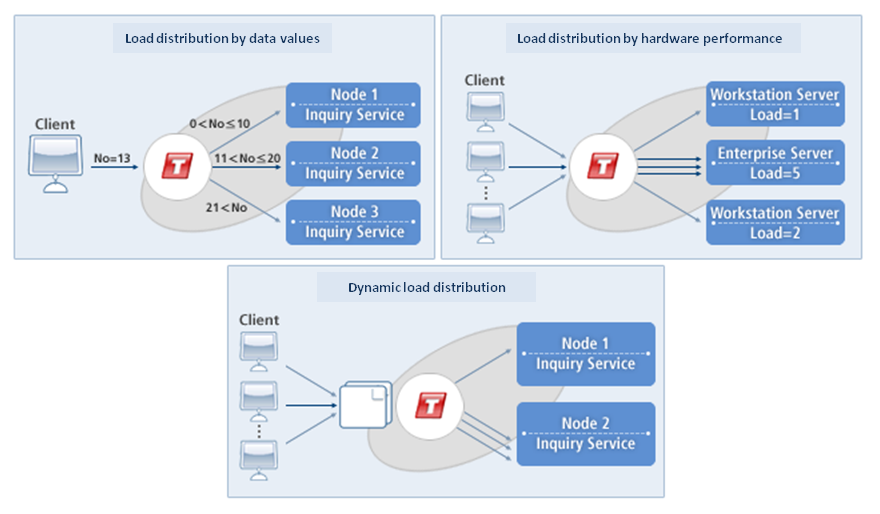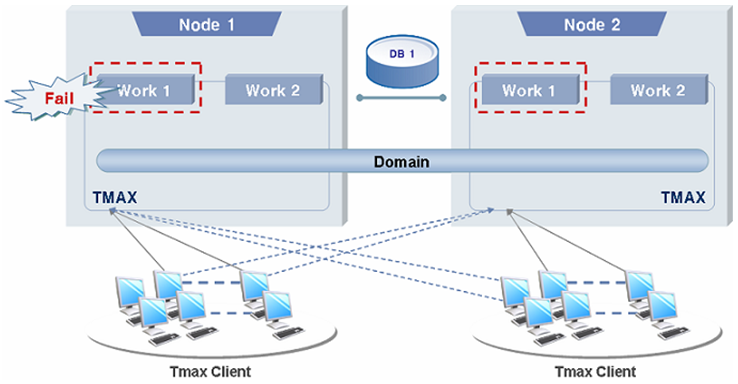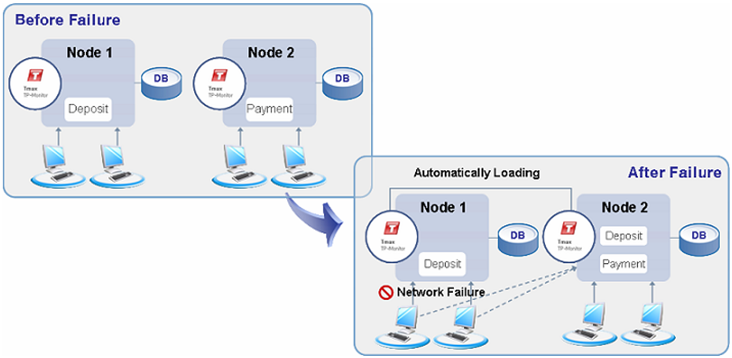Introduction to OpenFrame
This chapter describes the key features and benefits of OpenFrame and compares the IT environment before and after rehosting.
1. Overview
OpenFrame is a rehosting solution that migrates mainframe applications and data to an open system with minimum modifications and redevelopment efforts.
Before migration, it is important to consider the preservation of application logic, which is an important company asset and knowledge, in addition to the conversion of existing data and business applications. Moving data and applications can be costly and risky as redeveloping legacy source code that has been optimized for older hardware can introduce bugs and inconsistencies. Although difficult and expensive, it has become a necessity for businesses to integrate existing mainframes with new technology as mainframes are rapidly becoming obsolete and unable to adapt to rapidly changing business requirements.
OpenFrame allows the reuse of existing applications and data in an open system, greatly reducing the conversion cost and time and preserving important application logic.
-
Benefits of OpenFrame
When migrating from a mainframe to an open system with OpenFrame, existing application logic and processes can be reused with little modification. This allows the migration process to be completed in a relatively short period of time. It also prevents the inevitable system instability caused by a full redevelopment and the time-consuming troubleshooting efforts to fix these instabilities.
A key component of OpenFrame is the Tmax TP monitor, a program that monitors and manages transactions. Many TmaxSoft customers have successfully used Tmax and Tmax provides services that are missing in other rehosting products. Tmax engine updates can be applied to OpenFrame as needed to ensure a top-notch performance.
-
Applications of OpenFrame
OpenFrame can be used in any business sector where mainframes are currently used.
Because business markets are rapidly changing, companies that require new application logic might first lean towards the Big Bang method instead of rehosting. However, it is not difficult to expand application functions or integrate with new business environments such as the Internet after rehosting with OpenFrame. OpenFrame can be used to rehost any mission critical applications while maintaining the existing applications and avoiding the side-effects of a full redevelopment.
2. Features
OpenFrame offers many features that make it an excellent choice for a rehosting solution.
-
Built on a verified middleware solution
A rehosting solution that merely moves mainframe applications to an open system environment is of little use. A rehosting solution needs to provide levels of stability and performance that match or exceed those of the mainframe.
Because it is built on the powerful, market-verified Tmax TP monitor, OpenFrame can provide a stable and efficient migration process as well as transaction processing environment.
-
A comprehensive rehosting solution that supports both online and batch applications
Most rehosting solutions provide suitable environments for either online or batch applications, not both. Therefore, in traditional rehosting projects, software from multiple vendors must be used to provide a complete business environment.
OpenFrame, however, is a comprehensive rehosting solution that provides all the components needed to facilitate the operation of both online and batch applications in an open system.
-
Integration in an open environment
Integration may not be a critical issue immediately after mainframe rehosting. However, as the needs to expand the business application system or integrate with other systems rises, OpenFrame provides superior functionality compared to other rehosting vendors.
Tmax integrates with other commercial X/Open DTP XA-compliant transaction processing monitors, such as Tuxedo. Tmax ensures that OpenFrame-based systems can connect to most external tools, programs, and systems.
Additionally, OpenFrame can integrate seamlessly and reliably with the web by incorporating TmaxSoft’s advanced Web Application Server (WAS), JEUS®(JEUS). OpenFrame modules are implemented on TP-Monitor and WAS, which are the latest technologies for an open environment, that allow OpenFrame to support next-generation systems. By employing standards-based TP-Monitor and WAS technologies, OpenFrame supports high scalability and compatibility with other systems.
-
Load distribution and fault tolerance
When rehosting, two or more machines are typically used to achieve the performance of the existing mainframe system. In this situation, a rehosting solution must distribute system load between the machines and handle any hardware failures. OpenFrame provides both load distribution and failure recovery features to allow full and efficient use of system resources.
OpenFrame systems are usually comprised of multiple real or virtual nodes that are linked together to form a multi-node environment called a domain. If the system frequently experiences high loads, more nodes can be added to the system so that other nodes can partially or fully take over when a node is overloaded or fails.
Tmax provides powerful load balancing features that enable transaction requests to be distributed among the nodes of the system. The following diagram shows three load distribution methods.

-
Resource load can be distributed across multiple nodes or server processes according to the data value.
-
The system administrator can assign a value to each node or server process that reflects hardware performance. Transactions are distributed based on these values.
-
Tmax can monitor process loads throughout the system. If a node receives too many transaction requests, further requests can be rerouted to less-busy nodes.
The following diagram shows the recovery process of a failed node.

As mentioned already, OpenFrame systems are typically composed of multiple real or virtual nodes linked together in a peer-to-peer relationship. These nodes monitor each another, enabling the system to quickly react to a node failure. This peer-to-peer relationship enables multiple backups to be configured and strengthens both software and hardware fault tolerance.
As shown in the previous diagram, both Node 1 and Node 2 are capable of processing the same applications. If Node 1 experiences a software failure while processing Work 1, Node 2 can receive all subsequent transaction requests for Work 1. The failed server process in Node 1 can then be restarted.
The
 symbol represents transaction requests before the server process failure, and the
symbol represents transaction requests before the server process failure, and the  symbol represents transaction requests after the failure.
symbol represents transaction requests after the failure.OpenFrame systems can also recover from hardware or network failures as follows:

If an unexpected failure occurs, Tmax detects the failure and attempts to restart the failed server. However, if a node cannot be fully recovered, all requests directed to the failed node will be automatically forwarded to another node to ensure continuity of service.
As shown in the previous figure, if there is a network failure, and clients cannot connect to Node 1 to request deposit transactions; in this case, Tmax will automatically detect this failure and establish a connection to Node 2 instead. Subsequent deposit transaction requests will then be routed to Node 2.
-
-
Implementation of JCL at the engine level
Most rehosting solutions use inefficient and overly-complex scripts such as the UNIX shell to implement JCL.
In contrast, OpenFrame incorporates an advanced JCL processing engine called TJES that can run JCL files without modification.
-
Convenient process management
You can monitor all server processes and trace their transactions from end to end in an OpenFrame system. Tmax module enables you to monitor a wide range of system statistics that can be adjusted to improve system performance.
-
Other benefits of rehosting
Rehosting with OpenFrame offers the following additional benefits:
-
Scalability and compatibility
OpenFrame can be installed on a range of system environments, such as IBM, HP, and SUN. OpenFrame can communicate with other systems and peripheral components by using a variety of interfaces, including TCP, X.25, SNA, Gateway, Java, TP Gateway. New services can also be easily integrated into OpenFrame as a module.
-
Cost reduction
Unlike in a complete redevelopment where applications must be converted at a high development cost, OpenFrame reuses existing software and application data. This saves both time and cost for rehosting as well as potential cost for future redevelopment.
-
Maintain mainframe workforce
When a system is completely redeveloped for a new platform, you must replace the engineers of the legacy system who lack the skill sets to administer the new system. After rehosting, however, the existing engineers can manage the new system because it is comparable to the old system.
-
Application logic inheritance
Rehosting conserves most of the original business logic and the integrity of the legacy applications, data, and other resources.
-
Integrated management and development environment
OpenFrame provides a convenient GUI environment for monitoring and managing the system. The GUI environment can also be used to develop new COBOL and JCL applications for the system.
-
3. Environment Comparison
The following table compares mainframe system components with their OpenFrame counterparts.
| Environment | Mainframe | OpenFrame |
|---|---|---|
Operating System |
MVS (OS.390, z/OS) |
UNIX |
Hardware |
IBM (mainframe) |
HP, SUN, IBM (P-series) |
Record Management |
VSAM |
TSAM |
TP Monitor |
CICS |
OSC |
Database |
DB2 |
Tibero, UDB, Oracle |
IMS/DB |
OpenFrame HiDB |
|
User Interface |
BMS/MFS, Web, 4GL |
OpenFrame Mapping Support, Web, 4GL |
Batch Job |
JES |
TJES |
Programming Language |
COBOL, PL/I |
COBOL, PL/I, C/C++ |
Communication Protocol |
SNA |
TCP/IP |
Character Set |
EBCDIC |
ASCII |
4. Mainframe Terminology
The goal of rehosting is to migrate mainframe applications to an open system without any modification to the original business logic. Therefore, OpenFrame has been designed with components that look and function comparably to those of the mainframe. In OpenFrame manuals, many functions are described in relation to their mainframe counterparts. For this reason, OpenFrame users should be familiar with some basic mainframe components and terminology.
The following is a brief list of mainframe terminology. A more complete list can be found in the "Glossary" with a list of OpenFrame terminology.
-
Time Sharing Option/Interactive System Productivity Facility (TSO/ISPF)
TSO is a user interface for accessing mainframe services from a terminal.
ISPF is a series of menus used to manage the system, and compile and manage applications.
-
Customer Information Control System (CICS)
CICS is a transaction processing system designed for online use.
-
Information Management System (IMS)
IMS can be divided into two subsystems: database (DB) and data communication (DC).
The DB subsystem sets up and maintains a complex hierarchical database, while DC controls data communication.
-
Job Entry Subsystems2 (JES2)
JES2 is the job management system of a mainframe system.
-
Job Control Language (JCL)
JCL is responsible for passing jobs to the OS, allocating hardware devices and data sets, and controlling the execution of applications.